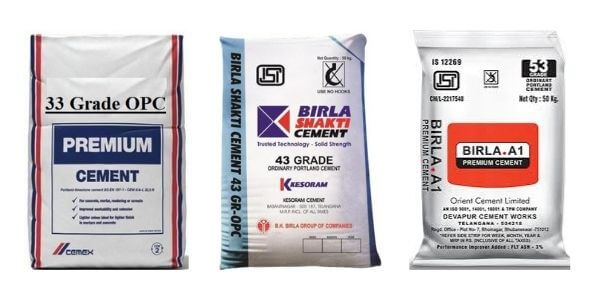Table of Contents
Grade of Cement
The cement grade refers to the cement compressive strength which means how much strength cement can yield or bear.
These cement grades are classified according to the compressive strength of the cement, tested after 28 days.
As we all know, cement is the vital ingredient of concrete, and its strength is directly proportional to concrete strength.
Hence before buying the cement for constructing your dream home, you should have sufficient information about the grade of cement.
The grade of cement is a numerical value to measure its compressive strength. As the cement grade increases, its strength increases.
Selection of a particular cement grade should be done as per the requirements and nature of the work.
Difference Between 33 43 and 53 Grade Cement
Ordinary Portland cement (OPC) has 3 grades that are
- 33-Grade,
- 43-Grade,
- 53-Grade.
As per the Bureau of Indian Standard, these grades are differentiated by their compressive strengths, expressed in megapascal (Mpa) which is N/mm2.
Compressive strength is a ratio of load per unit area. The load is calculated in newton (N) and the area is calculated in mm2. Differences between 33, 43 and 53-grade cement are as follows:

IS Codes
For 33 grade IS 269 is used.
For 43 grade IS 8112 is used.
For 53 grade IS 12269 is used.
Compressive Strength
For calculation of compressive strength cement sand and water are mixed vibrated and cured and cubes are made.
These cubes are tested in the laboratory at 27°C after 3 days, 7 days and 28 days. Cement grade indicates the compressive strength of cement concrete after 28 days of setting.
| S.No. | Grade of Cement | Compressive Strength in 3 days (N/mm2) | Compressive Strength in 7 days (N/mm2) | Compressive Strength in 28 days (N/mm2) |
| 1. | 33grade | 16 | 23 | 27 |
| 2. | 43grade | 22 | 33 | 37 |
| 3. | 53grade | 33 | 43 | 53 |
Also, Read – AAC Blocks – Properties, Advantages, Disadvantages and Laying Process.
Initial Strength
Here you can see the initial strength of 53-grade cement is higher than 33-grade or 43-grade cement. The strength of the 53 grade does not increase much after 28 days because of early strength gain.
While 33-grade and 43-grade cement continue to gain strength after 28 days. With time 33 and 43-grade cement will attain the same ultimate strength as that of 53-grade cement.
Heat of Hydration
During the initial setting 53-grade cement releases heat of hydration at a much faster rate as compared to 33 and 43-grade cement.
Therefore, the chances of microcracking are much greater and these micro-cracks may not be visible on the surface.

Many times site supervisors or masons increase the quantity of cement in the mix. They think that it will increase the strength and the durability of concrete. But it creates micro-cracks in the concrete.
Hence 53-grade cement should be used only where such applications are warranted for making concrete of higher strength, where good supervision and quality assurance measures are in place and where proper precautions are taken to reduce the higher heat of hydration through a proper curing process.
43-grade cement releases medium heat of hydration.
33-grade cement releases low heat of hydration.
Also, Read – What is M sand? Properties, Advantages and Disadvantages
Price
The price of 33-grade cement is lower than 43-grade cement.
The price of 43-grade cement is higher than 33-grade but lower than 53-grade cement.
The price of 53-grade cement is higher than 33 and 43-grade cement.
Uses
Nowadays 33-grade cement is rarely used. As most of the manufacturers have sifted to PPC. 33-grade cement is commonly used for making concrete of low strength such as below M20 concrete grade.
43-grade cement is used in PCC and RCC works, preferably where the grade of concrete is up to M30. Also, it is recommended for plastering, tiling, brickwork and stone masonry, flooring, pathway etc. Where initial days strength, not prime importance. It is also used to finish all types of buildings, bridges, culverts, roads, water retaining structures etc.
53 grade OPC cement is recommended in all RCC structures like footing, columns, beams and slabs where initial and ultimate strength is the major structural requirement. It can also be used for RCC work where the grade of concrete is M30 and above. It is also used for
- High-rise buildings, Industrial work,
- A precast concrete item such as paving blocks, tiles, building blocks, pipes, railway sleepers, poles etc.
- Prestressed concrete work like bridges, silos etc.
- Runway, concrete roads, bridges.
- Cold weather concreting, cement grouts, instant plugging etc
Conclusion
Every grade of cement is suitable for a different set of tasks. Each of them has a varying level of strength, using the wrong strength levels for a particular job can affect your overall structural design.
If you find this information helpful please don’t forget to share it.
Finally thanks! for reading the article.
Also, read
10 – Best cement Companies in India
Soundness Test of Cement By Le-Chatelier Apparatus
Specific gravity of Cement – Definition, Importance, Test Procedure
Unit Weight of Building Materials Used in Construction